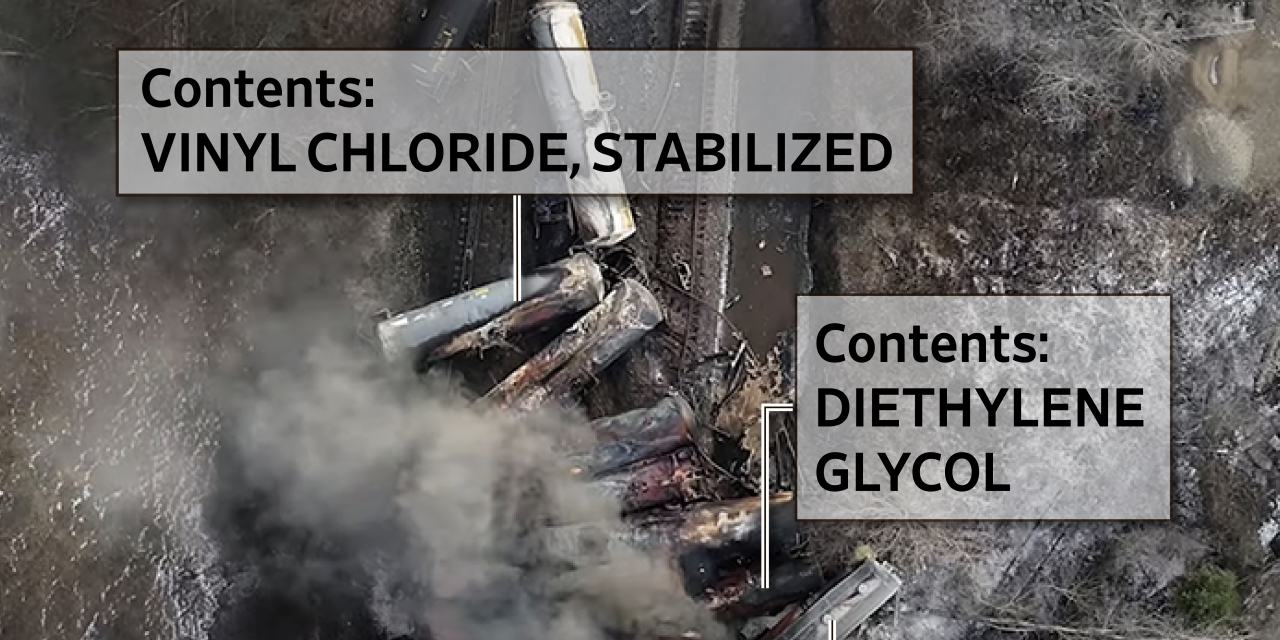Investigation Into Persistent Toxic Chemicals After Ohio Train Derailment

Table of Contents
Identification of Persistent Toxic Chemicals Released
The Ohio train derailment involved the release of several hazardous materials, some known for their persistence in the environment and potential for long-term health impacts. Key among these are:
-
Vinyl Chloride: A colorless gas used to make PVC plastic, vinyl chloride is classified as a human carcinogen. It is volatile and can quickly disperse in the air, but it can also persist in soil and groundwater. Exposure can lead to various health problems, including liver damage and an increased risk of liver cancer.
-
Butyl Acrylate: This colorless liquid is used in paints, coatings, and adhesives. While less persistent than vinyl chloride, butyl acrylate can still contaminate soil and water. Inhalation can cause respiratory irritation, and skin contact can lead to dermatitis.
-
Ethylhexyl Acrylate: Similar to butyl acrylate, this chemical is used in various industrial applications. It presents similar health risks, including respiratory and skin irritation.
Identifying and quantifying these chemicals involved sophisticated analytical techniques, including gas chromatography-mass spectrometry (GC-MS) and high-performance liquid chromatography (HPLC). The persistence of these chemicals is a key concern. Vinyl chloride, for example, has a relatively short half-life in the air, but its degradation products can persist longer. The potential for bioaccumulation, where the concentration of these chemicals increases within living organisms over time, is also a major factor in assessing long-term risks.
Extent of Environmental Contamination
The environmental contamination resulting from the Ohio train derailment extends across multiple media:
-
Soil Contamination: Significant soil contamination has been reported in the vicinity of the derailment site. The extent of the contamination is still being assessed, with ongoing sampling and analysis to determine the precise levels of hazardous chemicals present in the affected soil.
-
Water Contamination: Both surface water and groundwater have been affected. Testing has revealed the presence of contaminants in nearby waterways, raising concerns about drinking water safety and the potential impact on aquatic life. The long-term effects on groundwater are a significant concern given its slow replenishment rate.
-
Air Pollution: The initial release of chemicals resulted in a significant air pollution event. While the immediate threat has subsided, the potential for long-term air quality issues remains a subject of ongoing investigation and monitoring.
The ecological damage is also a major concern. The contamination of soil and water could have devastating effects on local wildlife, plant life, and the overall health of the ecosystem. Ongoing monitoring and remediation efforts are crucial to assess the full extent of the damage and to mitigate future harm.
Assessment of Health Risks to the Community
Exposure to the released chemicals poses significant health risks to the East Palestine community. Potential health effects include:
-
Respiratory Problems: Inhalation of vinyl chloride and other chemicals can lead to immediate respiratory irritation and, in the long term, increase the risk of respiratory diseases.
-
Skin Irritation: Contact with butyl acrylate and ethylhexyl acrylate can cause skin irritation, dermatitis, and other skin problems.
-
Long-Term Cancer Risks: Exposure to vinyl chloride is linked to an increased risk of liver cancer and other cancers. The long-term effects of exposure to other released chemicals are still under investigation.
The government has initiated medical screenings for residents, focusing on respiratory issues and other potential symptoms. However, the long-term health implications for exposed individuals remain a major concern, necessitating ongoing monitoring and comprehensive healthcare support.
Government Response and Regulatory Actions
The Environmental Protection Agency (EPA) and other government agencies have launched a significant response to the Ohio train derailment. This includes:
-
Cleanup Efforts: The EPA has overseen the cleanup of contaminated soil and water, focusing on removing hazardous materials and preventing further spread.
-
Regulatory Oversight: The incident has sparked calls for increased regulatory oversight of hazardous materials transport and stricter safety protocols to prevent future accidents.
-
Public Health Response: Government agencies are working to provide medical screenings and support to the affected community. However, questions remain about the adequacy and transparency of the response.
Assessing government accountability and the effectiveness of the regulatory response is crucial. Learning from this incident and implementing preventive measures is vital to minimize the risk of future environmental disasters involving the release of persistent toxic chemicals.
Conclusion
The Ohio train derailment underscores the devastating consequences of accidental releases of persistent toxic chemicals. The long-term health and environmental impacts are still unfolding, demanding ongoing monitoring, rigorous scientific investigation, and proactive governmental intervention. The identified persistent pollutants pose significant risks, necessitating a comprehensive and transparent response to protect both the community and the environment.
Call to Action: Continued investigation into the persistent toxic chemicals released in the Ohio train derailment is crucial to fully understand the scope of the damage and develop effective long-term strategies for remediation and prevention. Further research into the long-term health effects and a transparent commitment to community support are vital for ensuring the well-being of East Palestine residents. Stay informed about updates on the investigation into persistent toxic chemicals following the Ohio train derailment.

Featured Posts
-
 Jessica Simpson And Birdie Adorable Twins In Yellow Swimsuits
May 12, 2025
Jessica Simpson And Birdie Adorable Twins In Yellow Swimsuits
May 12, 2025 -
 Dechiffrage De La Resistance De L Euro Malgre Les Tensions Actuelles
May 12, 2025
Dechiffrage De La Resistance De L Euro Malgre Les Tensions Actuelles
May 12, 2025 -
 80 Game Ban For Jurickson Profar A Closer Look At The Ped Suspension
May 12, 2025
80 Game Ban For Jurickson Profar A Closer Look At The Ped Suspension
May 12, 2025 -
 Is Offshore Oil Drilling Viable In Uruguay A Comprehensive Look
May 12, 2025
Is Offshore Oil Drilling Viable In Uruguay A Comprehensive Look
May 12, 2025 -
 Unprecedented Night Two Celtics Players Score 40 Points
May 12, 2025
Unprecedented Night Two Celtics Players Score 40 Points
May 12, 2025
Latest Posts
-
 Senior Travel Calendar Planned Trips Activities And Events
May 13, 2025
Senior Travel Calendar Planned Trips Activities And Events
May 13, 2025 -
 Pegula Falls To Sabalenka In Miami Open Final
May 13, 2025
Pegula Falls To Sabalenka In Miami Open Final
May 13, 2025 -
 Sabalenka Claims 19th Wta Title Beats Pegula In Miami
May 13, 2025
Sabalenka Claims 19th Wta Title Beats Pegula In Miami
May 13, 2025 -
 Aryna Sabalenkas Miami Open Victory 19th Career Title
May 13, 2025
Aryna Sabalenkas Miami Open Victory 19th Career Title
May 13, 2025 -
 Sabalenka And Gauffs Dominant Performances Secure Rome Advance
May 13, 2025
Sabalenka And Gauffs Dominant Performances Secure Rome Advance
May 13, 2025
